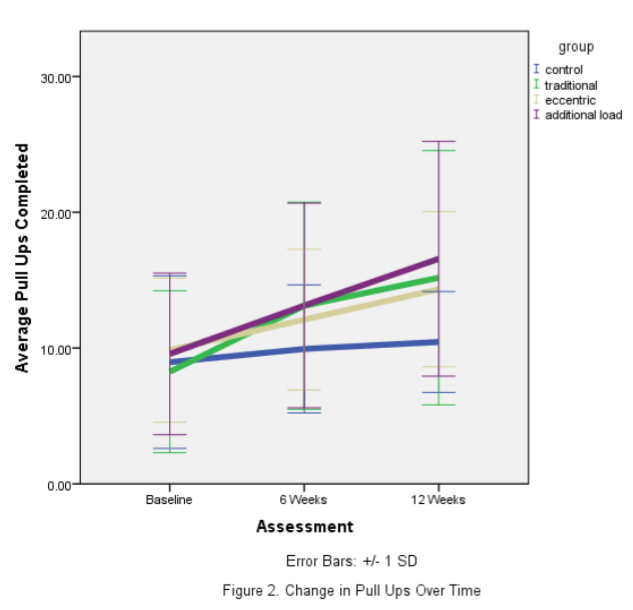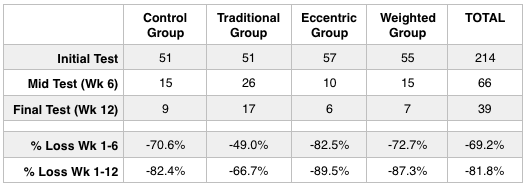
By Adam Scott, MS, CSCS
What is the best way to improve pull-ups?
In July 2015 we conducted a Pilot Study trying to answer that very question. Building on our little study, twelve weeks ago, Dr. Eric Martin of California State University Monterery Bay (CSUMB) started a much larger, academic experiment using athletes from MTI, Grit Strength and Conditioning and students from CSUMB.
Dr. Martin’s results are in…and it turns out that the answer might not be as simple as we had hoped.
Quick Review
The study began with 214 initial participants. All participants were randomly divided into four training groups:
(1) Control Group – No pull-up training
(2) Traditional Training – Trained with “regular pull-ups
(3) Eccentric Training – Trained pull-up “negatives”
(4) Weighted Training – Trained pull-ups with additional load
Each group trained their pull-up method twice per week for twelve weeks as a part of a regular training program.
To assess their improvement participants completed a maximum repetition pull-up test three times during the study:
(1) An initial assessment at the beginning of the study
(2) A mid-cycle assessment during week 6
(3) A final assessment at the conclusion of the study (week 12)
Results and Discussion
-
- No single demographic statistic was correlated to changes in Pull-Up performance during the first six weeks: Not height, weight, age, initial performance…nothing.
– This was particularly surprising because one would expect there to be some connection between these measures and pull-up changes – especially the athlete’s initial performance.
- No single demographic statistic was correlated to changes in Pull-Up performance during the first six weeks: Not height, weight, age, initial performance…nothing.
-
- There was no significant difference between the eccentric training group and the control group during the first six weeks.
– This finding was contrary to what we found in our pilot study. Although we employed a slightly different training protocol, we found that eccentric training produced the largest improvement of all training programs.
- There was no significant difference between the eccentric training group and the control group during the first six weeks.
Pull-Up Performance Week 1-12:
-
- The Eccentric Group finally showed significant improvement during the second 6 weeks.
– It was odd that the eccentric group’s improvement was slower than the other two training groups (traditional and weighted). Perhaps this says something about the type and time-frame of eccentric training adaptation, but this study was not designed to specifically assess this.
- The Eccentric Group finally showed significant improvement during the second 6 weeks.
-
- When compared to the control group, ALL GROUPS SHOWED SIMILAR IMPROVEMENTS BY THE END OF THE STUDY – WEEK 12.
– Against our assumptions, based on this study, essentially, all forms of training are pretty much equally effective.
- When compared to the control group, ALL GROUPS SHOWED SIMILAR IMPROVEMENTS BY THE END OF THE STUDY – WEEK 12.
GRAPH 1: Average Pull-Ups By Group (Courtesy of Dr. Eric Martin)

Every study loses participants, but when we look at the fall-off experienced in this study the numbers are pretty staggering. TABLE 1 shows the drop-off of participants at each assessment.

For us at MTI the attrition rate is doubly-troubling. Our push towards research means trying to complete more studies like this one. Losing 70% of participants in the first six weeks and another 10% during the final six weeks is going to make answering research questions difficult.
Overall Conclusions
As a practical recommendation…we conclude that, if you are dedicated to two days a week, five sets max, just do normal pull ups. Do not waste your time with eccentrics, and do not waste your money buying a weight vest.
– Dr. Eric Martin
Questions, Comments, Feedback? Please send them to coach@mtntactical.com
Improve your Pull Up Performance with MTI’s Pull Up Improvement Training Packet
